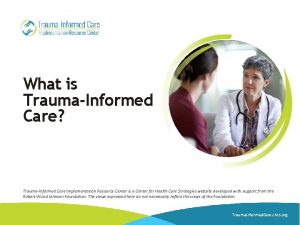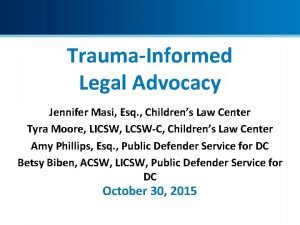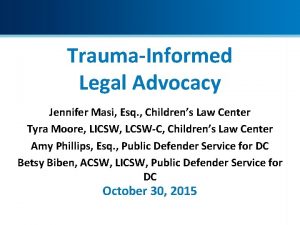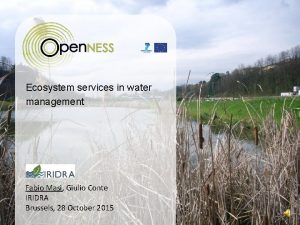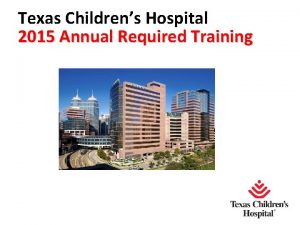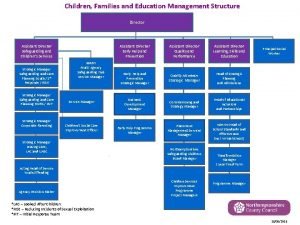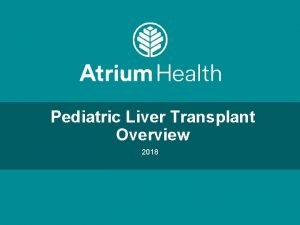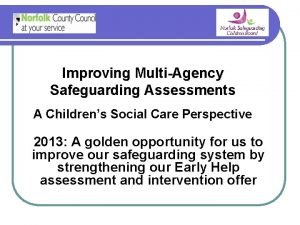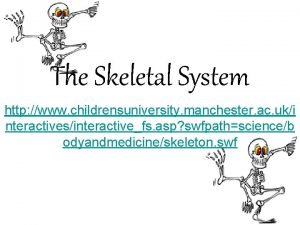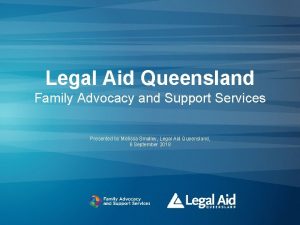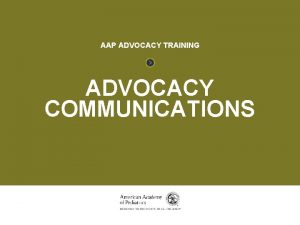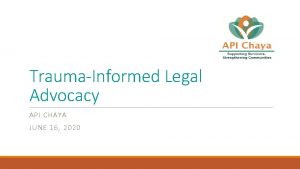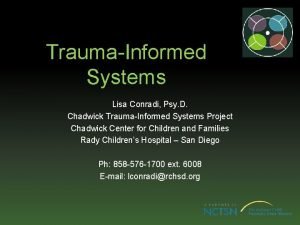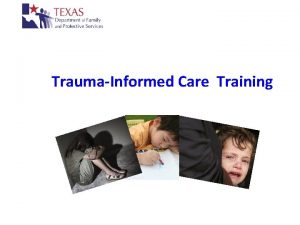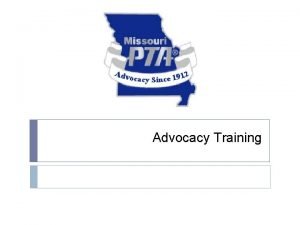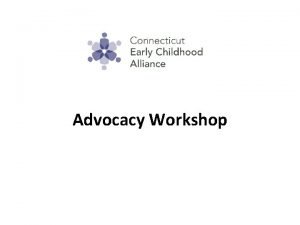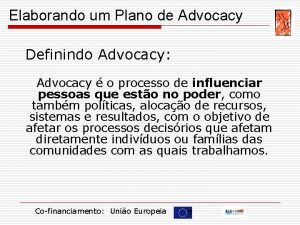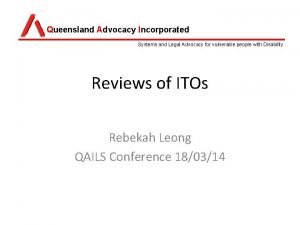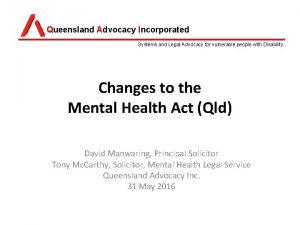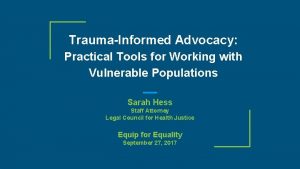TraumaInformed Legal Advocacy Jennifer Masi Esq Childrens Law































- Slides: 31

Trauma-Informed Legal Advocacy Jennifer Masi, Esq. , Children’s Law Center Tyra Moore, LICSW, LCSW-C, Children’s Law Center Amy Phillips, Esq. , Public Defender Service for DC Betsy Biben, ACSW, LICSW, Public Defender Service for DC October 30, 2015

Overview of Today’s Presentation • Reconceptualize teen behaviors using a trauma lens • Discuss tangible tools and varied perspectives • End with key takeaways

Caveats • CLC’s practice is best interest. • PDS’s practice is stated interest. • Trauma is not one-size-fits-all!

Guided Imagery Experience

Reconceptualizing Teen Client Behaviors Using a Trauma Lens

Negative Behaviors & Labels Negative Behaviors • Acting out in home, school, community • Physical, verbal aggression • Running away • Destruction of property • Poor school performance • Truancy, attendance concerns • Promiscuity, prostitution, sexual abuse of others • Delinquent, criminal behavior Related Labels • • Manipulative “Bad” kid, out of control Negative attention seeking Delinquent, criminal, hangs with the wrong crowd Lazy, poor student Bully Substance abuser Sex addict, promiscuous

Using a Trauma Lens • What questions will help reframe the conversation? • What happened to this individual? • For a client in the neglect system, what brought him/her into care? What is his/her placement history? • Does the individual feel safe? At home? School? In the community? • What need is being met by the behaviors? • What basic needs are not met? • Is there an attachment to anyone? What are those relationships like?

Reframing Behaviors • Running away • Feeling unsafe in the home • Physically aggressive • Protecting himself/herself from perceived danger • Poor grades • Executive functioning challenges • Promiscuity • Believing value lies in what they can physically offer another person • Irritability/impulsivity • Constant scanning of environment for danger • Bed-wetting • Subconscious perception of danger overnight • Substance abuse • Coping strategy to manage constant state of hypervigilance

Trauma Symptomology vs. Psychopathology • Common misdiagnoses: • • • ADD, ADHD Depression Oppositional defiant disorder Conduct disorder Bipolar disorder • Changes from DSM IV to DSM V

ADD Symptoms vs. Trauma Symptoms Attention Deficit Disorder (ADD) Symptoms Trauma Symptoms Impulsivity Stress responses to trauma triggers, rapid mood shifts Inability to focus, distractibility Hypervigilance, dissociation, fatigue from insomnia, intrusive thoughts Agitation, frequent shifts in mood Emotional dysregulation

Depressive Symptoms vs. Trauma Symptoms of Depression Trauma Symptoms Depressed mood, constant feelings of sadness Emotionally detached, dissociation, emotional numbness Insomnia Sleep disturbances, intrusive thoughts, hypervigilance, nightmares leading to fear of sleeping Feelings of worthlessness or guilt around things out of his/her control Diminished self-worth, feelings of shame/guilt for “allowing” the trauma to happen Isolation, distrust of others because of feeling unsafe

Perspectives & Practice Pointers

Attorney Perspective & Advocacy Tips

Information Gathering • What do you know about your teen client’s past and potential trauma history? • What do you want to know? What happened to your client before you met him/her?

Information Gathering • How do you gather more information? • Once you have gathered information about your client’s trauma history, what do you do with it? • Organize the information • Share the information as appropriate

Ethical & Strategic Considerations • What is your duty to your client? • What is most appropriate for your advocacy? • Best interest vs. stated interest • How will your teen client respond? • Will your client agree with your decisions (i. e. , to share information with others)? How much does that impact your advocacy?

Trauma-Informed Treatment • Does your client need this? • Don’t assume that every teen client needs trauma -informed treatment. • Does your client need this now? • If you determine that your client needs or could benefit from trauma-informed treatment, then you should next consider when this treatment should occur. • Does your client want this?

Trauma-Informed Treatment • How do you ensure your client obtains this treatment? • Once you have determined that it is time to advocate for trauma-informed treatment for your client, how do you advocate for effective treatment? • How do you advocate when your client already receives mental health services? Are the services appropriate? • Don’t assume that your client’s service provider is trauma-informed or providing trauma-informed treatment.

Reframing the Discussion • How can we reframe the discussion with our teens with trauma? • Some considerations: • You aren’t bad – something bad happened to you. • I don’t think you are trying to do bad things. You are trying to keep yourself safe and sometimes that results in behavior that does not have a good consequence. • There are things that you did do to keep yourself safe – that’s a strength. • Can we find some new things that will keep you safe but have positive consequences?

Reframing the Discussion • How can we reframe the discussion with others on the teen’s team? • Some considerations: • Help team members (caregivers, social workers, judges, schools, etc. ) see beyond the teen’s behaviors. • Share resources on trauma to educate others. • Discuss the teen’s trauma if appropriate. • Acknowledge the teen’s accountability as needed. • It’s important to balance the trauma with accountability. It’s about reframing, not excusing.

Changing Our Approach • Recognize that it can be impossible at times for our teens with trauma to put their experiences into words. • Even when they can put their experiences into words, it can be (or can feel) unsafe for them to do so. • Understand the impact of triggering and that anything and anyone can serve as a reminder of past trauma. • Sometimes just listening and validating the teen’s experience is the most important/helpful thing to do when a client is triggered.

Sometimes the Best Thing • Consult with a clinician. • We are not therapeutic providers. • Listen to your client. • Be empathetic. • “That must have been hard. ” • Remember that outcomes will vary by case.

Social Work Perspective on Teens in Court

Teen Participation in Court • Child Welfare Cases • Should teens with trauma attend hearings? • If so, how should the teen participate?

Teen Participation in Court • Delinquency / PINS Cases • No choice about client attending court • Matters at the bench versus in open court • Warn client that court/prosecutor engagement/attitude can be challenging • Discuss self-advocacy

Preparing for the Courtroom • How do you prepare your teen client for coming to court? • What do you do on the day of the hearing?

Engaging the Teen in Court • Teens often feel they have no voice or are not understood. • What can be done to lessen the tension and increase the teen’s trust in the process? • What steps can judges take to gain greater participation in the process?

When Teens Testify • Child Welfare Cases • Is it in the child’s best interest to testify? • Delinquency / PINS Cases • Does the child choose to testify?

Key Takeaways • The significant impact of trauma • The reconceptualization of negative behaviors • The use of a trauma lens in advocacy

Questions?

Resources • • • • The Institute for Advanced Psychotherapy Training and Education, Inc. , Liza Ferentz Founder and President National Child Traumatic Stress Network: http: //nctsnet. org/ The Child Trauma Academy, Dr. Bruce Perry: http: //www. childtrauma. org Trauma Center at Justice Resource Institute, Dr. Bessel van der Kolk, Boston, Massachusetts National Center for Trauma Informed Care (SAMHSA): http: //www. samshsa. gov/nctic National Center for PTSD: http: //www. ptsd. va. gov Marsh, S. , Dierkhising, C. , Decker, K. , Rodiak, J. , Preparing for a Trauma Consultation in your Juvenile and Family Court. National Council of Juvenile and Family Court Judges (2015) Perry, B. , The Boy Who was Raised as a Dog and Other Stories from a Child Psychiatrist’s Notebook, (2007) Glenn N. Saxe, B. Heidi Ellis & Julie B. Kaplow, Collaborative Treatment of Traumatized Children and Teens: The Trauma Systems Therapy Approach (Guilford Press ed. , 2009) (2007) Child Welfare Info. Gateway, Understanding the Effects of Maltreatment on Brain Development (Issue Brief April 2015): https: //www. childwelfare. gov/pub. PDFs/brain_development. pdf Amy Ellis Nutt & Frances E. Jensen, The Teenage Brain (Harper 2015) National Child Traumatic Stress Network: NCTSN Bench Card for the Trauma-Informed Judge: http: //www. nctsn. org/products/nctsn-bench-card-trauma-informed-judge National Child Traumatic Stress Network: Identifying and Providing Services to Young Children Who Have Been Exposed to Trauma: For Professionals: http: //www. nctsnet. org/content/identifying-and-providingservices-young-children-who-have-been-exposed-trauma-professionals
 Traumainformed care
Traumainformed care Jennifer masi
Jennifer masi Jennifer masi
Jennifer masi Gregory b jordan esq
Gregory b jordan esq Adam smith esq
Adam smith esq I.c. atripalda de amicis-masi
I.c. atripalda de amicis-masi Silvia masi sapienza
Silvia masi sapienza Polizia locale terre estensi ferrara voghiera masi torello
Polizia locale terre estensi ferrara voghiera masi torello Indice pf
Indice pf Fabio masi
Fabio masi Dr masi khaja
Dr masi khaja Moli texas children's
Moli texas children's Christian childrens fund
Christian childrens fund Childrens services
Childrens services Childrens services walsall
Childrens services walsall Levine childrens
Levine childrens 23 april international children's day turkey
23 april international children's day turkey Kirklees safeguarding childrens board
Kirklees safeguarding childrens board Childrens literature quiz
Childrens literature quiz Manchester childrens university
Manchester childrens university Longman children's picture dictionary
Longman children's picture dictionary Black childrens memorial
Black childrens memorial Childrens temperature chart
Childrens temperature chart History of childrens literature
History of childrens literature Junior book awards 2018
Junior book awards 2018 Newton's first law and second law and third law
Newton's first law and second law and third law Newton's first law of motion
Newton's first law of motion Boyles law
Boyles law Avogadro's law constants
Avogadro's law constants Natural law vs positive law
Natural law vs positive law Legal aid townsville
Legal aid townsville Unit 1 introduction to law and the legal system
Unit 1 introduction to law and the legal system
